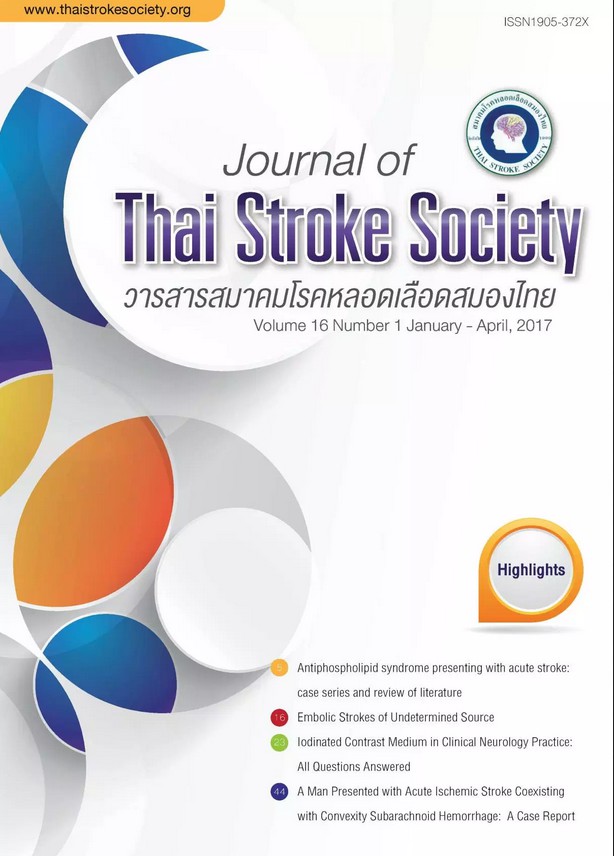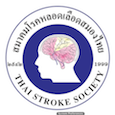Iodinated Contrast Medium in Clinical Neurology Practice: All Questions Answered
Keywords:
iodinated contrast medium, neurology, adverse reactions, contrast extravasation, contrast-induced nephropathyAbstract
Iodinated contrast medium (ICM) has been widely used for opacification of vascular structures, cerebrospinal fluid and other pathologies in neuroimaging via intravenous, intra-arterial and intrathecal routes. In this article, the authors explore several aspects of ICM use in clinical neurology practice using a question-and-answer format. This encompasses the molecular basis, categories, mechanisms of action, effects to the body, side effects, complications, preventive measures and managements of these unwanted effects
References
Justesen P, Downes M, Grynne BH, et al. Injection-associated pain in femoral arteriography: a European multicenter study comparing safety, tolerability, and efficacy of iodixanol and iopromide. Cardiovasc Intervent Radiol. 1997;20(4):251-6.
Wang CL, Cohan RH, Ellis JH, et al. Frequency, Management, and Outcome of Extravasation of Nonionic Iodinated Contrast Medium in 69 657 Intravenous Injections. Radiology. 2007;243(1):80-7.
Thomsen HS, Webb JA. Contrast media: Berlin Heidelberg, Springer; 2014:245-51.
ACR Committee on Drugs and Contrast Media. ACR manual on contrast media: version 10.2: American College of Radiology Web site; Published 2016 [cited 2016 August, 15]. Available from: http://www.acr.org/~/media/37D84428BF1D4E1B9A3A2918DA9E27A3.pdf/.
Heinrich MC, Haberle L, Muller V, et al. Nephrotoxicity of iso-osmolar iodixanol compared with nonionic low-osmolar contrast media: meta-analysis of randomized controlled trials. Radiology. 2009;250(1):68-86.
U.S. Food and Drug Administration. FDA Approved Drug Products: FDA/Center for Drug Evaluation and Research; [cited 2016 August, 25]. Available from: http://www.accessdata.fda.gov/scripts/cder/drugsatfda/index.cfm.
Widmark JM. Imaging-related medications: a class overview. Proc (Bayl Univ Med Cent). 2007;20(4):408-17.
Bae KT. Intravenous Contrast Medium Administration and Scan Timing at CT: Considerations and Approaches. Radiology. 2010;256(1):32-61.
Smirniotopoulos JG, Murphy FM, Rushing EJ, et al. Patterns of contrast enhancement in the brain and meninges. Radiographics. 2007;27(2):525-51.
Shrier DA, Tanaka H, Numaguchi Y, et al. CT angiography in the evaluation of acute stroke. AJNR Am J Neuroradiol. 1997;18(6):1011-20.
Pinto RS, Berenstein A. The Use of Iopamidol in Cerebral Angiography. Investigative Radiology. 1984;19(5):S222-4.
Bettmann M. Angiographic contrast agents: conventional and new media compared. AJR Am J Roentgenol. 1982;139(4):787-94.
Pfeiffer FE, Homburger HA, Houser OW, et al. Elevation of serum creatine kinase B-subunit levels by radiographic contrast agents in patients with neurologic disorders. Mayo Clin Proc.1987 May;62(5):351-7.
Pasternak JJ, Williamson EE. Clinical Pharmacology, Uses, and Adverse Reactions of Iodinated Contrast Agents: A Primer for the Non-radiologist. Mayo Clin Proc. 2012;87(4): 390-402.
American College of Radiology. ACR–ASNR–SIR–SNIS Practice Parameter for the Performance of Diagnostic Cervicocerebral Catheter Angiography in
Adults. American College of Radiology Web site: American College of Radiology Website; [updated 2016; cited 2016 September, 20]. Available from: http://www.acr.org/~/media/261A171F55D744439FAACD9C61B0D462.pdf.
American College of Radiology. ACR-ASNR-SPR practice parameter for the performance of myelography and cisternography: American College of Radiology Website; [updated 2013; cited 2016 October 10, 2016]. Available from: http://www.acr.org/~/media/ACR/Documents/PGTS/guidelines/Myelography.pdf.
Menon BK, d’Esterre CD, Qazi EM, et al. Multiphase CT Angiography: A New Tool for the Imaging Triage of Patients with Acute Ischemic Stroke. Radiology. 2015;275(2):510-20.
Yang CY, Chen YF, Lee CW, et al. Multiphase CT angiography versus single-phase CT angiography: comparison of image quality and radiation dose. AJNR Am J Neuroradiol. 2008;29(7):1288-95.
Barrett BJ, Parfrey PS, Vavasour HM, et al. A comparison of nonionic, low-osmolality radiocontrast agents with ionic, high-osmolality agents during cardiac catheterization. N Engl J Med.1992;326(7):431-6.
Bøhn H, Reich L, Suljaga-Petchel K. Inadvertent intrathecal use of ionic contrast media for myelography. AJNR Am J Neuroradiol. 1992;13(6):1515-9.
Visipaque (iodixanol) injection [prescribing information]. Princeton, NJ: GE Healthcare, May 2006. [ cited September 20, 2016].
McClennan B. Contrast media alert. Radiology. 1993;189(1):35.
Van der Leede H, Jorens P, Parizel P, et al. Inadvertent intrathecal use of ionic contrast agent. Eur Radiol. 2002;12(3):S86-S93.25. Omnipaque (iohexol) injection [product insert]. Princeton, NJ: GE Healthcare, May 2006. [cited September 20, 2016].
Lee BY, Ok JJ, Abdelaziz Elsayed AA, et al. Preparative fasting for contrast-enhanced CT: reconsideration. Radiology. 2012;263(2):444-50.
Beckett KR, Moriarity AK, Langer JM. Safe Use of Contrast Media: What the Radiologist Needs to Know. Radiographics. 2015;35(6):1738-50.
Morcos S, Thomsen H. Adverse reactions to iodinated contrast media. Eur Radiol. 2001;11(7):1267-75.
Schopp JG, Iyer RS, Wang CL, et al. Allergic reactions to iodinated contrast media: premedication considerations for patients at risk. Emerg Radiol. 2013;20(4):299-306.
Davenport MS, Cohan RH, Caoili EM, et al. Repeat Contrast Medium Reactions in Premedicated Patients: Frequency and Severity. Radiology. 2009;253(2):372-9.
Thomsen HS. European Society of Urogenital Radiology guidelines on contrast media application. Curr Opin Urol. 2007;17(1):70-6.
Namasivayam S, Kalra MK, Torres WE, et al. Adverse reactions to intravenous iodinated contrast media: a primer for radiologists. Emerg Radiol. 2006;12(5):210-5.
Duncan L, Heathcote J, Djurdjev O, et al. Screening for renal disease using serum creatinine: who are we missing? Nephrol Dial Transplant. 2001;16(5):1042-6.
Schwartz GJ, Work DF. Measurement and estimation of GFR in children and adolescents. Clin J Am Soc Nephrol. 2009 Nov;4(11):1832-43.
European Society of urogenital radiology. ESUR guidelines on contrast media. European Society of urogenital radiology: European Society of urogenital radiology Website; [updated 2012; cited 2016 August, 10]. Available from: http://www.esur.org/guidelines/#.
Mruk B. Renal Safety of Iodinated Contrast Media Depending on Their Osmolarity–Current Outlooks. Pol J Radiol. 2016;81:157.
Nguyen SA, Suranyi P, Ravenel JG, Randall PK, Romano PB, Strom KA, et al. Iso-Osmolality versus Low-Osmolality Iodinated Contrast Medium at Intravenous Contrast-enhanced CT: Effect on Kidney Function. Radiology. 2008;248(1):97-105.
Hopyan J, Gladstone D, Mallia G, et al. Renal safety of CT angiography and perfusion imaging in the emergency evaluation of acute stroke. AJNR Am J Neuroradiol. 2008;29(10):1826-30.
Lima F, Lev M, Levy R, et al. Functional contrast-enhanced CT for evaluation of acute ischemic stroke does not increase the risk of contrast-induced nephropathy. AJNR Am J Neuroradiol. 2010;31(5):817-21.
Sudarsky D, Nikolsky E. Contrast-induced nephropathy in interventional cardiology. Int J Nephrol Renovasc Dis. 2011;4:85-99.
Bettmann MA. Frequently Asked Questions: Iodinated Contrast Agents. Radiographics. 2004;24:S3-S10.
Webb JAW, Thomsen HS, Morcos SK. The use of iodinated and gadolinium contrast media during pregnancy and lactation. Eur Radiol. 2005;15(6):1234-40.
Katzberg RW, Newhouse JH. Intravenous Contrast Medium–induced Nephrotoxicity: Is the Medical Risk Really as Great as We Have Come to Believe? Radiology. 2010;256(1):21-8.
Tao SM, Wichmann JL, Schoepf UJ, et al. Contrast-induced nephropathy in CT: incidence, risk factors and strategies for prevention. Eur Radiol. 2015:1-9.
Bruce RJ, Djamali A, Shinki K, et al. Background fluctuation of kidney function versus contrastinduced nephrotoxicity. AJR Am J Roentgenol. 2009;192(3):711-8.
McDonald RJ, McDonald JS, Bida JP, et al. Intravenous contrast material–induced nephropathy: causal or coincident phenomenon? Radiology. 2013;267(1):106-18.
Downloads
Published
How to Cite
Issue
Section
License
ข้อความภายในบทความที่ตีพิมพ์ในวารสารสมาคมโรคหลอดเลือดสมองไทยเล่มนี้ ตลอดจนความรับผิดชอบด้านเนื้อหาและการตรวจร่างบทความเป็นของผู้นิพนธ์ ไม่เกี่ยวข้องกับกองบรรณาธิการแต่อย่างใด การนำเนื้อหา ข้อความหรือข้อคิดเห็นของบทความไปเผยแพร่ ต้องได้รับอนุญาตจากกองบรรณาธิการอย่างเป็นลายลักษณ์อักษร ผลงานที่ได้รับการตีพิมพ์ในวารสารเล่มนี้ถือเป็นลิขสิทธิ์ของวารสาร





